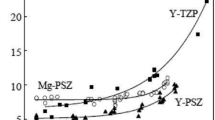Abstract
The mechanical behavior of zirconium ceramics with different porosities (456 and 1330 MPa) is studied with an accent on the fracture toughness (the study of other characteristics in a wide temperature range plays an auxiliary role) The tests are predominantly performed with the use of a Vickers pyramid (theIF andIS methods) and under flexure (theSEVNB andSENB methods) The results of the indentation and subsequent bending of the specimens are used to plot aR-curve that turns out to be plane It is shown that despite the substantial difference in the strength of the studied variants of ceramics their crack resistance differs inconsiderably The values of the critical coefficients of stress intensity determined by various methods for the same ceramics are shown to differ The results obtained are analyzed using the data of a micro-Raman analysis The tests for crack resistance by the method ofSEVNB (bending of a beam with a polishedV-notch) show that the specimens do not undergo a tetragonal-monoclinic phase transformation during the deposition of a stress concentrator
Similar content being viewed by others
References
R. C. Garvie, R. H. J. Hannik, and R. T. Pascoe, “Ceramic steel?”Nature,258(5537), 703–704 (1975).
A. H. Heuer, “Transformation toughening in ZrO2-containing ceramics,”J. Am. Ceram. Soc,70(10), 689–698 (1987).
A. V. Vikar and R. I. K. Matsumoro, “Ferroelastic domain switching as a toughening mechanism in tetragonal zirconia,”J. Am. Ceram. Soc,69(10), 244–266 (1986).
G. A. Gogotsi and E. E. Lomonova, “A micro-Raman study of phase transformations in zirconia crystals upon indentation of a Vickers pyramid,”Ogneup. Tekh. Keram., No. 6, 4 – 9 (2000).
G. A. Gogotsi and M. V. Swain, “Comparison of strength and fracture toughness of single and polycrystalline zirconia,” in:Science and Technology of Zirconia V, Technomic Publishing Co., Lancaster-Basel (1993), pp. 347–359.
G. A. Gogotsi, V. I. Galenko, and B. I. Ozerskii, “Crack resistance and other characteristics of ceramics from partially stabilized zirconia with an additive of iron oxide,”Ogneup. Tekh. Keram., No. 2, 2 – 9 (1996).
J. W. Adams, R. Ruh, and K. S. Mazdiyashi, “Young’s modulus, flexural strength, and fracture of yttria-stabilized zirconia versus temperature,”J. Am. Ceram. Soc,80(4), 903–908 (1997).
G. Quinn, J. Kubier, and R. Gettings, “Fracture toughness of advanced ceramics by the surface crack in flexure (SCF) method: A VAMAS Round Robin,”VAMAS Report No. 17, NIST,Gaithersurg, MD, USA, June, 1994.
G. A. Gogotsi, “Deformation behavior of zirconia materials,”Probl. Prochn., No. 6, 106 – 115 (1998).
G. A. Gogotsi and V. I. Galenko, “Crack resistance of zirconia ceramics and crystals at room and low temperatures,”Probl. Prochn.,No.3, 104 –118 (1997).
“ISO/FDIS 14704, Fine ceramics (advanced ceramics, advanced technical ceramics): Test method of flexure strength of monolithic ceramics at room temperature,” in:Final Draft International Standard, International Organization for Standardization (2000).
G. A. Gogotsi, “Crack resistance of ceramics and composites with a ceramic matrix(SEVNB method),”Ogneup. Tekh. Keram., No. 11, 7 – 13(1998).
“ASTM C-1421, Standard test methods for the determination of fracture toughness of advanced ceramics at ambient temperatures,” in:ASTM Standard (1999).
“ISO 14705, Fine ceramics (advanced ceramics, advanced technical ceramics): Test method for hardness of monolithic ceramics at room temperature,” in:International Standard, International Organization for Standardization (2000).
B. R. Lawn and D. B. Marshall, “Hardness, toughness and brittleness: An indentation analysis,”J. Am. Ceram. Soc,62 (7 – 8), 347–350 (1979).
D. B. Marshall and A. G. Evans, “Reply to comment on elastic/plastic indentation damage in ceramics: The median/radial crack system,”J. Am. Ceram. Soc.,64 (12), 182–183 (1981).
G. R. Anstis, et al., “A critical evaluation of indentation techniques for measuring fracture toughness: I. Direct crack measurements,”J. Am. Ceram. Soc.,64 (9), 533–538 (1981).
T. Miyoshi, et al.,Trans. Jpn. Soc. Mech. Eng.,51A, 2489 (1989).
K. Niihara, et al., “Evaluation of KIc of brittle solids by the indentation method with low crack-to-indent ratios,”J. Mater. Sei. Lett.,1, 13–16 (1982).
P. Chantikul, G. R. Anstis, B. R. Lawn, and D. B. Marshall, “A critical evaluation of indentation techniques for measuring fracture toughness: II. Strength method,”J. Am. Ceram. Soc.,64(9), 539–543 (1981).
R. L. K. Matsumoto, “Evaluation of fracture toughness determination methods as applied to ceria-stabilized tetragonal zirconia polycrystal,”J. Am. Ceram. Soc.,70 (12), 366–368 (1987).
Z. Li, A. Ghosh, A. S. Kobayashi, and R. C. Brandt, “Indentation fracture toughness of sintered silicon carbide in the Palmqvist crack regime,”J. Am. Ceram. Soc.,72(6), 904–911 (1989).
R. F. Krause Jr., “Rising fracture toughness from the bending strength of indented alumina beams,”J. Am. Ceram. Soc.,71(5), 338–343 (1988).
A. K. Bhattacharya and J. J. Petrovic, “R-curve behavior in zirconia reinforced molybdenum disilicide composites,”J. Am. Ceram. Soc.,75(1), 23–27 (1992).
J. Kubier, “Fracture toughness of ceramics using theSEVNB method; Round Robin,” in:VAMAS Report No. 37, EISIS Document D2-99, Dubendorf, Switzerland, October 1995.
R. J. Primas and R. Gstrein, “ESIS TC 6 Round Robin on fracture Toughness of Ceramics: ECF 11,” in: J. Petit (ed.),Mechanisms and Mechanics of Damage and Failure, Vol.1, Press Ltd., London (1996).
P. Lemaitre and R. Piller, “Comparison of the fracture toughness of alumina measured by three different methods,”J. Mater. Sci. Lett.,7, 772–774 (1988).
S. R. Choi and J. A. Salem, “Crack growth resistance of in situtoughness silicon nitride,”J. Am. Ceram. Soc.,77 (4), 1042–1046 (1994).
T. L. Anderson,Fracture Mechanics: Fundamentals and Applications, CRC Press, Ann Arbor (1991).
Author information
Authors and Affiliations
Additional information
Transleted from Ogneupory i Technicheskaya Keramika, No. 8, pp. 7 – 13, August, 2000.
Rights and permissions
About this article
Cite this article
Gogotsi, G.A., Galenko, V.I., Ozerskii, B.I. et al. Fracture toughness, strength, and other characteristics of yttria-stabilized zirconium ceramics. Refract Ind Ceram 41, 257–263 (2000). https://doi.org/10.1007/BF02693761
Issue Date:
DOI: https://doi.org/10.1007/BF02693761




